Author Archives: admin
CPI rose by a whopping 0.6% in January
The Consumer Price Index (CPI) increased 0.6% in January on a seasonally adjusted basis according to the BLS. And while this is an increase of only 2.5% over the last 12 months, over the last 3 months, inflation has been rising at an annual rate of 4.1%.
According to the BLS, the January increase was the largest since February 2013. A sharp rise in gasoline prices accounted for nearly half the increase, and advances in prices for shelter, apparel, and new vehicles also were major contributors.
Lehigh Valley overall business sentiment rose in January
Business sentiment and the overall confidence in the local economy spiked in January over its October 2016 level according to the Kamran Afshar- Greater Lehigh Valley Chamber of Commerce survey. This is a quarterly survey of Lehigh Valley businesses which we have been doing since 1997. The increase in confidence was entirely due to the local businesses significant increase in their hiring and spending during the second half of 2016, while, interestingly enough, they trimmed down their plans for hiring and spending for the first half of 2017.
The hiring index for the last 6 months rose significantly in January, jumping by more than 10% above its October 2016 level. And it is back again in the range which is historically associated with faster growth in the Valley. The index visited this range briefly in 2015 also. Local employers are not only facing a smaller size labor pool, but of more significance, they are facing a thinning of skills and expertise within the remaining labor market. From high tech to low tech to no tech, many positions remain vacant for lack of qualified applicants.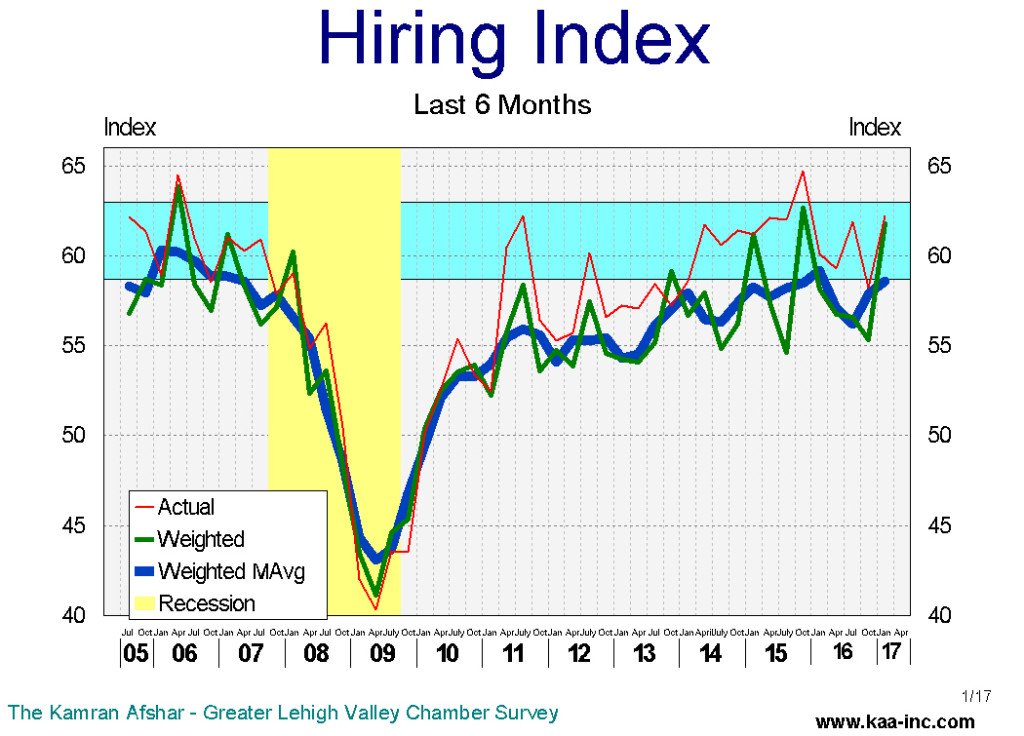
The purchasing index for last 6 months also recorded a more than 10% jump in January, pushing it to its highest level since 2007, before the recession.
It is however, most intriguing that the same businesses which reported such a large increase in their expenditures and hiring over the last 6 months, trimmed down their plans for future expenditures and hiring. The future index, while still indicates expansion, declined slightly in January.
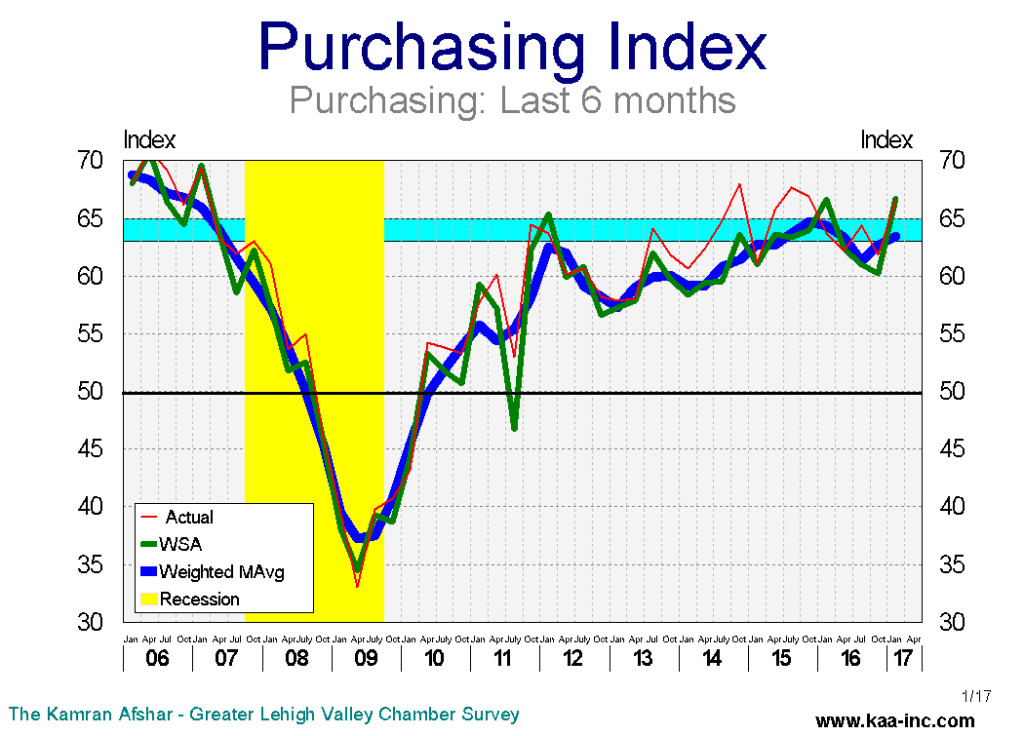
More than half of the local businesses with more than 100 employees reported net addition to their payrolls, while only 6% of them had net layoffs, according to the January survey. The larger companies in the Valley also led in the percentage increase in their expenditures. Sixty-five percent of them reported increases in their expenditures, while 18% cut back spending during the second half of 2016.
The smaller companies, those which have between 6 and 20 employees have the lead in plans for future hiring, with 44% of them planning to increase their employment levels in the next 6 months. And the smallest companies, those with fewer than 6 employees, which, incidentally, constitute half of all the businesses in the Valley, have the lead in planned future expenditures, with 33% of them planning to increase their spending during the first half of 2017.
The survey shows general optimism among local businesses. And one of the most tell-tell signs of the January survey is that the sharp improvement in the local businesses assessment of the past, came alongside with a slight decline in their sentiment about the future. This indicates great enthusiasm with some measure of caution about the future.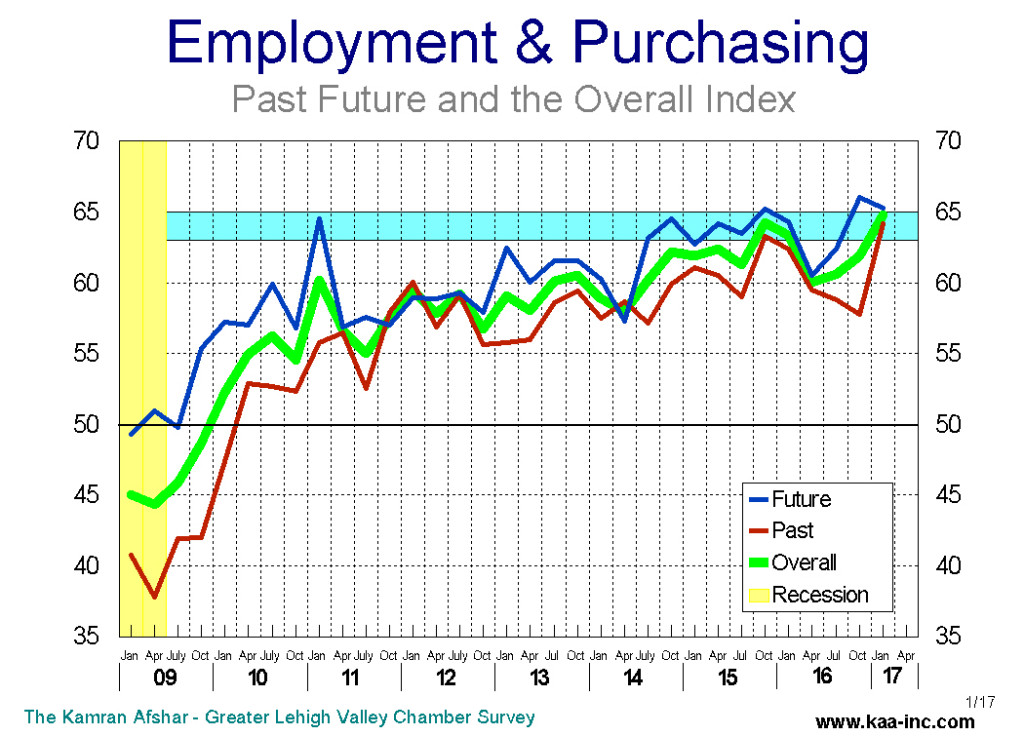
Business leaders cautiously optimistic about Trump at Lehigh Valley Chamber event
1/24/2017
Despite an air of uncertainty about the new Trump administration and its impact on Lehigh Valley businesses, speakers at Tuesday’s Greater Lehigh Valley Chamber of Commerce’s annual Economic Outlook luncheon sounded mostly upbeat notes, with a few words of caution.
The two-hour event at SteelStacks’ ArtsQuest Center in south Bethlehem drew an audience of about 700
To read more;
http://www.mcall.com/business/economy/mc-chamber-lehigh-valley-economic-outlook-20170124-story.html
TriCounty Chamber hears economic forecast
by: David A. Kostival, from The Reading Eagle
“Afshar spoke to the chamber as part of its annual economic forecast membership breakfast Thursday morning at the SunnyBrook ballroom in Lower Pottsgrove Township.”
“Technology is replacing jobs,” he said. ….. Many of these jobs have not gone to China; they have simply disappeared and will continue to do so as we continue to get into heavy automation,” Afshar said. “People say we don’t build anything anymore, but the truth is we produce twice as much as we did in the 1970s. We just don’t use as many people to do so.”
to read more click here
Lehigh Valley overall business sentiment up slightly
The Kamran Afshar- Greater Lehigh Valley Chamber of Commerce survey of Lehigh Valley businesses is done on a quarterly basis. In October we conducted our 68th quarterly survey of these series, and according to the survey, business sentiment and the overall confidence in the local economy rose slightly over its July level. Almost all of the increase was due to a sizeable expansion in business plans for future purchases.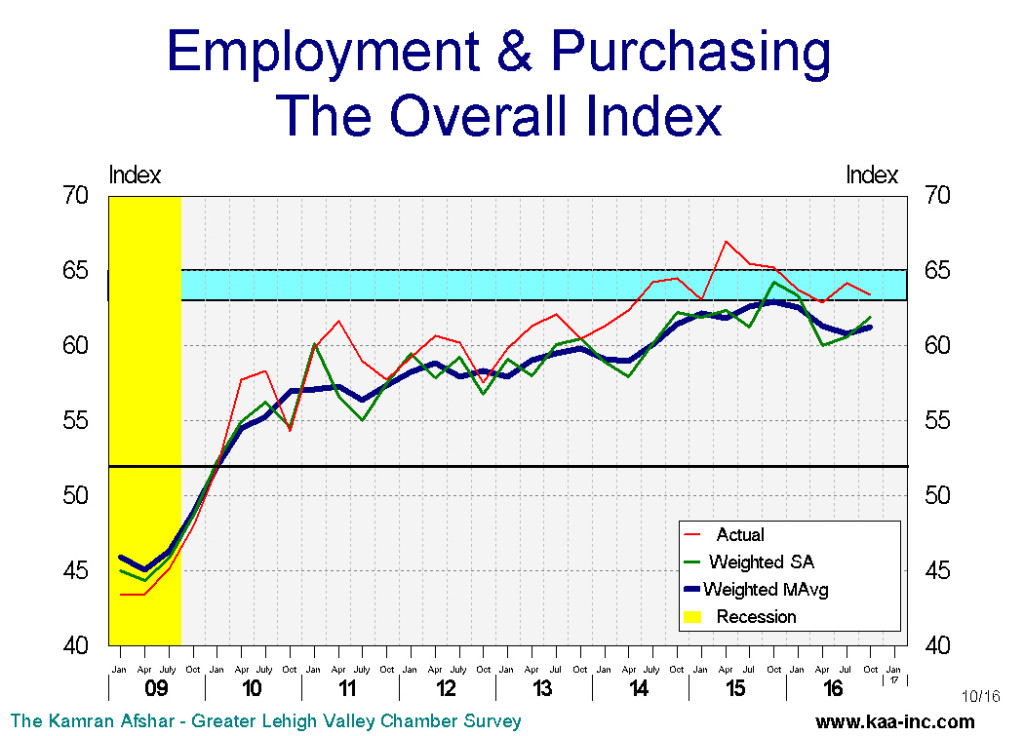
It should be noted that this survey was completed by October 19th, almost 3 weeks before the election.
In October, the index of plans for purchases over the next 6 months leaped by 10% above its July’s level, bring it to its highest level in the last 6 years. And of equal importance is that this index has now moved into the range that is historically associated with strong growth. Businesses with 21 to 50 employees have the lead in the October survey, where 45% of them are planning to increase their expenditures, while only 3% are planning cutbacks. 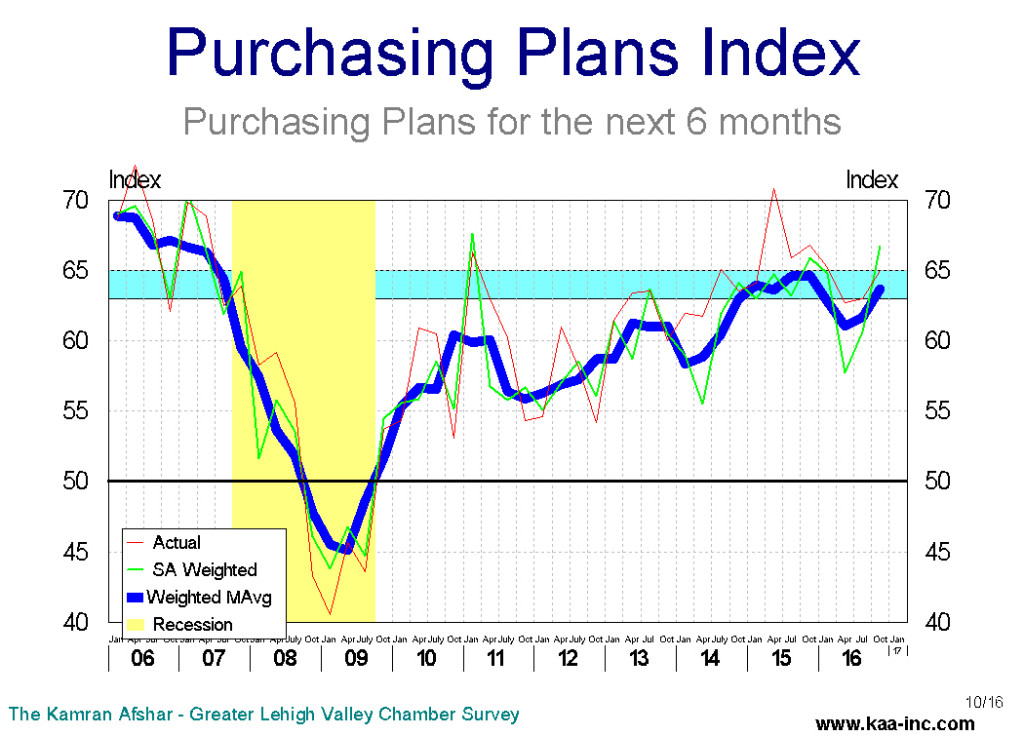
Hiring plans index for the next 6 months, is a shade higher than its July level, it has been very slowly moving up over the last 3 years and it is now at its highest level since April 2007, before the Great Recession. A third of local businesses are planning to hire more people, while 7% of them plan to lay off employees in the next 6 months. The layoff plans are now similar to what they were before the recession. 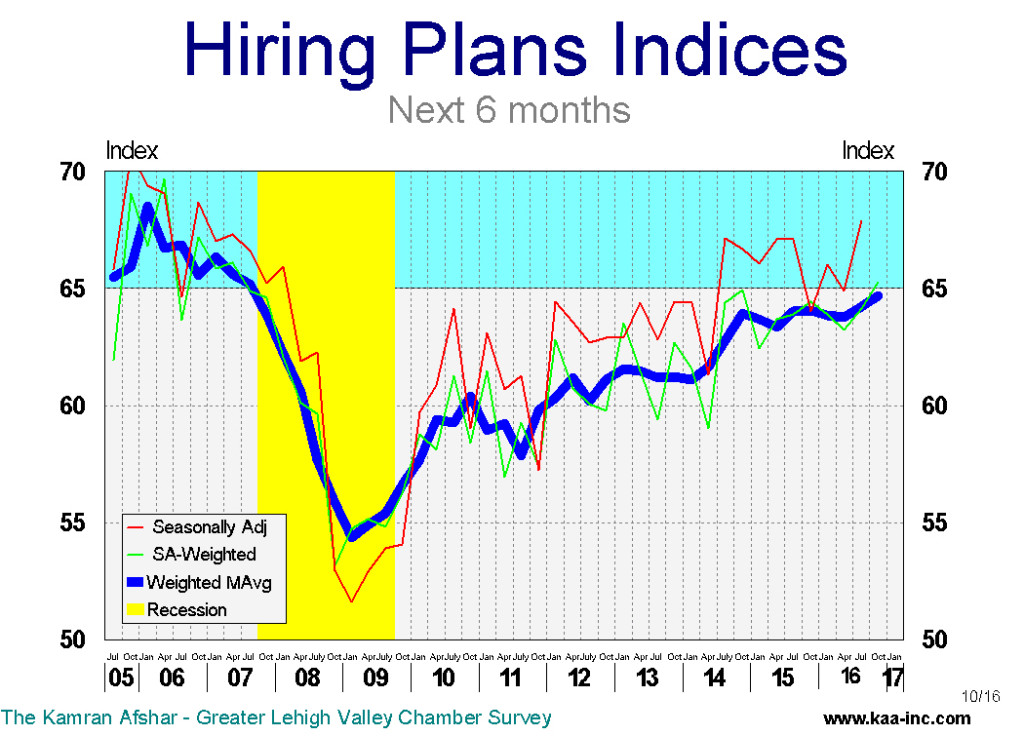
The average business participating in the survey is planning to hire 1.1 new employees in the next 6 months. While this is a significant increase over what local businesses were planning to hire back in 2013, it is just slightly higher than their plans were in 2014 or 2015.
Businesses with 51 to 100 employees lead to quest for hiring more people in the next 6 months. Businesses with less than 6 employees, which constitute half of all businesses in the Valley, show the lowest desire to increase employment in the near future.
Lehigh Valley businesses have slightly reduced their pace of hiring over the last 12 months. This is normal in a recovery; when a recovery starts, employers need all kinds of employees and the pool of unemployed is deep and filled with variety of skills. As a recovery matures, with employers having filled their general needs, are then looking for more specific skill sets. However, as a recovery matures the pool of labor becomes much shallower with significantly less variety. That’s why right now in the Valley, a number of employers cannot find the particular skills they are looking for. And this is not limited to high tech jobs, welders as well as many other low tech vacancies are left unfilled due to lack of qualified applicants. This has contributed to the small drop in the number new hires. The average business participating in the survey hired 0.6 new employees over the last 6 months.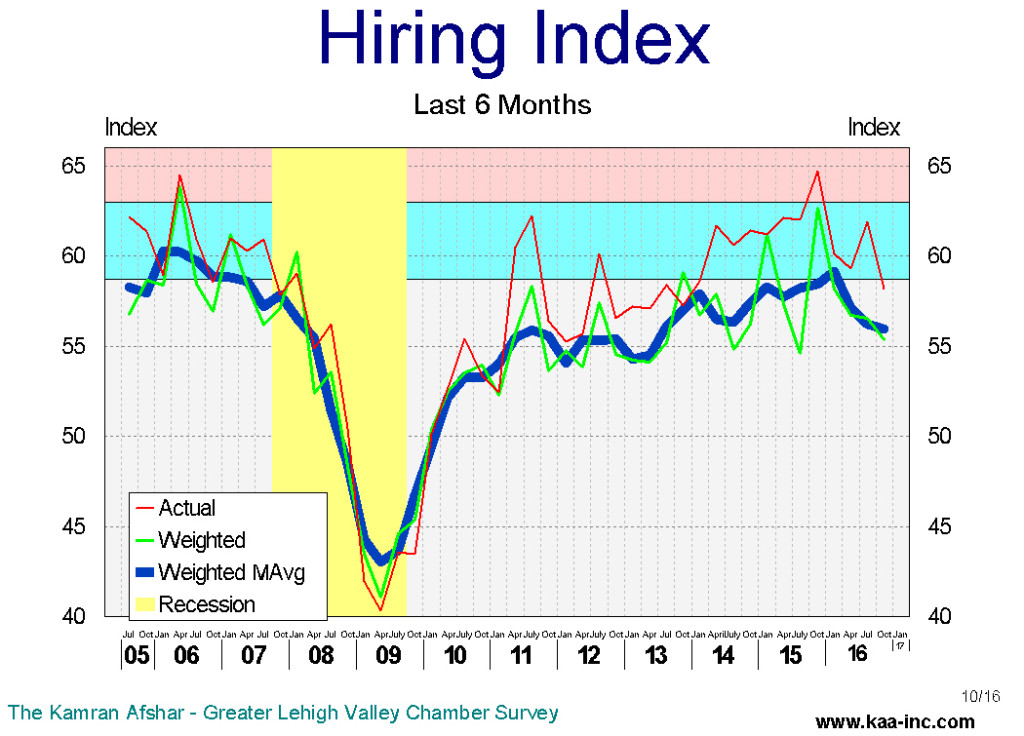
Companies with 11 to 20 employees led the group in new hires, and those with fewer than 6 employees were last on the list with a net zero addition to their employment ranks.
The index of actual purchasing has dropped 6% below its last year’s level. It should be noted that, overall, local businesses are increasing the amount of money they spent on purchases in the Valley. Over the last 6 months 36% of the local businesses increased their expenditures in the last 6 months while 16% reduced theirs, which means a net 20% of local business increased their expenditures over the last 6 months. The decline, is only relative, in October of 2015 a net 28% of local businesses increased their expenditures. And the decline, particularly in October was almost entirely due to the cutback in expenditures by companies which have between 51 to 100 employees. This has had a large impact since companies this size had been in the forefront of growth, particularly in the recent years. It should be noted that businesses with 51 to 100 employee participating in our survey are also the only category in the survey that has reported a decline in revenues over the last 6 months. 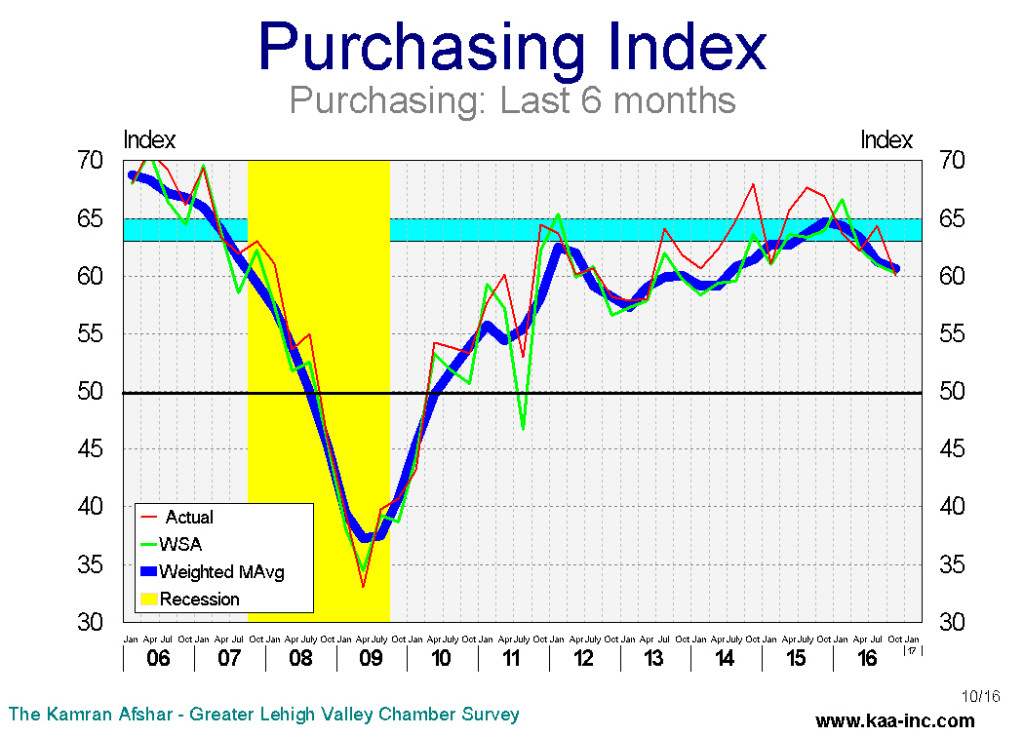
The average business participating in our survey increased its expenditures, by 3% in the last 6 months.
The index of actual revenues over the last 6 months has shown a small but steady decline this year. The October decline, not surprisingly, was entirely due to a drop in revenues of companies with between 51 to 100 employees. However, businesses with more than 100 employees reported the largest increase in their revenues in October. They were followed by those with 21 to 50 employees.
The index of expected future revenues, while oscillating widely, is continuing on a relatively flat trajectory. Businesses with 21 to 50 employees expecting to see the largest increase in the near future, with 69% of them expecting higher revenues while only 10% of them expect to see a drop. And interestingly enough, companies with 51 to 100 employees which were the only size companies who reported a drop in revenues over the last 6 months, overwhelmingly expect to see a significant increase in their revenues over the next 6 months. 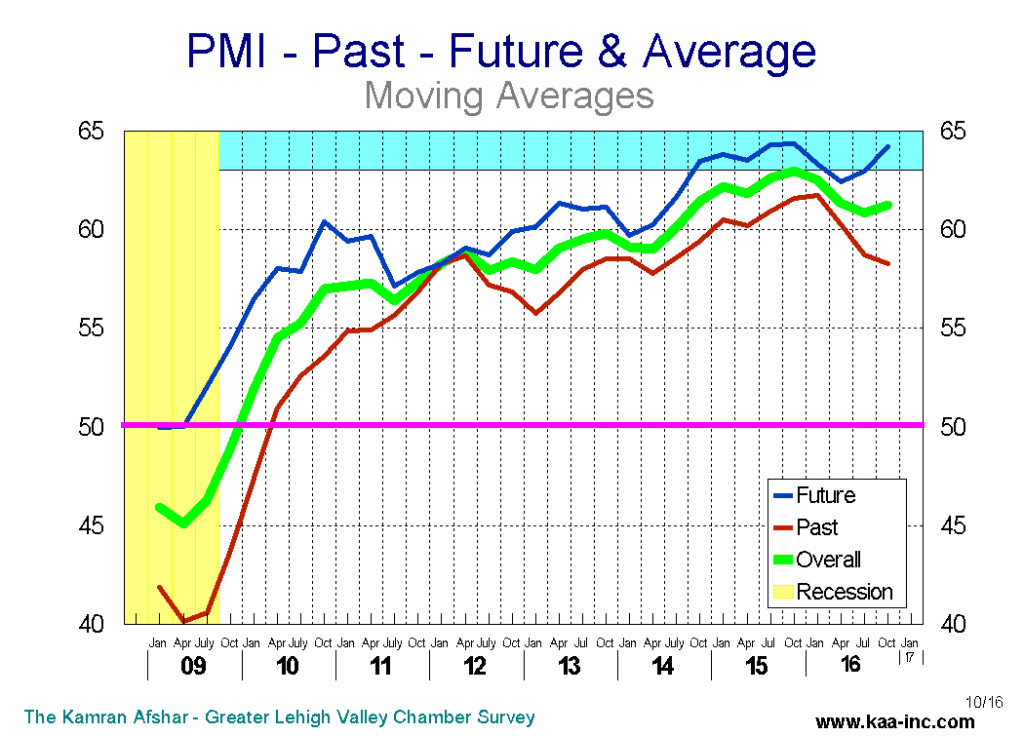
The October data shows an interesting split between the expectation of future and assessment of the past before the election. The split appears to be correlated with the level of uncertainty before the election. Business planning usually has very little to do with party politics. Business planning is about expected costs and projected revenues in the months to come. Both business costs and revenues are impacted by government policies. However, since businesses only know about the generalities of the new administration’s healthcare, tax, business and trade policies. Even those who enthusiastically welcome the change, don’t exactly know what are the new administration’s policies. In absence of specifics, time tables, congressional role, etc. business planning faces serious limitations. Similar to the period before the election, the uncertainty creates a wait and see attitude among businesses who will try to err on the side of caution. They have to wait until the new administration actually formulates its policies and then push them through either executive orders or the congress. If this process appears to be taking a long time, it will negatively impact the economic growth. On the other hand, if the new administration appears to be ahead of the game and formulates its policies rapidly, it may have a positive effect on economic growth. We will find out the answers to these questions in the next few months.
Lehigh Valley overall business sentiment slightly down since the beginning of the year
The Kamran Afshar- Greater Lehigh Valley Chamber of Commerce survey of Lehigh Valley businesses is done on a quarterly basis and collects around 700 observations per year. The Employment and Purchasing Index for the Lehigh Valley highlights the results of these surveys.
In July 2016 we conducted our 67th quarterly survey of these series, and according to the survey, business sentiment and the overall confidence in the local economy remained the same as in April, however, it is slightly lower than its January level. The index peaked back in October 2015.
.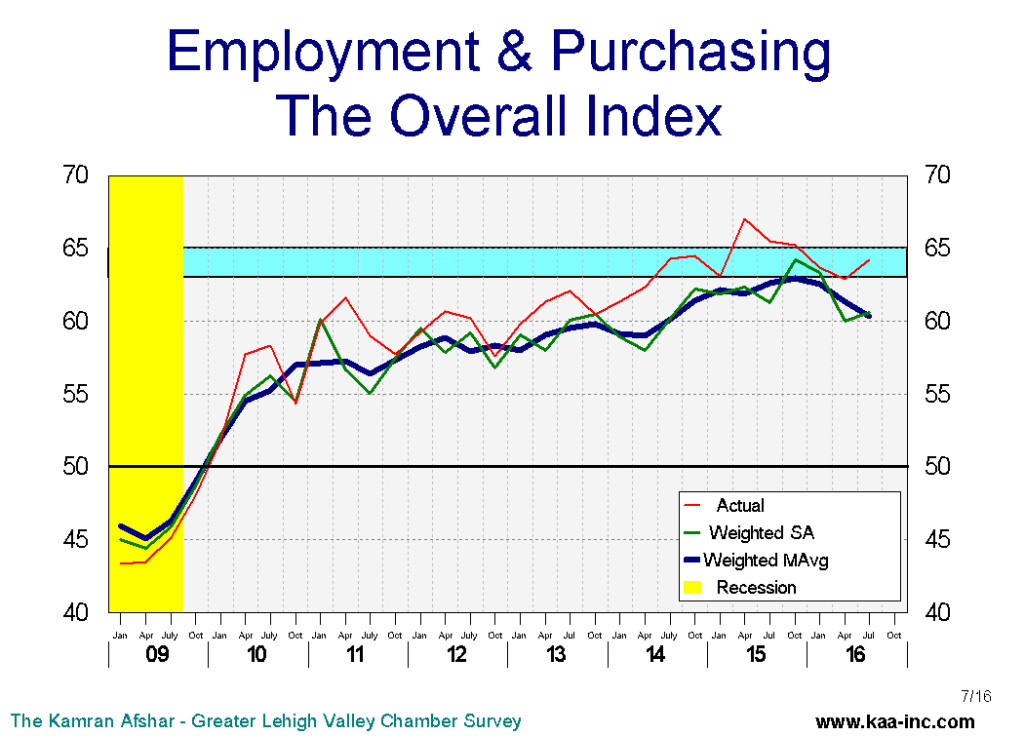
In July, the index of plans for future purchases rose by a significant 5% above its April’s level. And while it is still lower than its January’s level, some of its April decline has been reversed.
Actual expenditures over the last 6 months, however, have been trending down since last October.
Hiring plans index for the next 6 months, is a shade higher than its April level, however, it has been trending at an almost constant level for the last year-and-a-half. And of more importance, this level is very close to the range which is historically associated with strong employment growth.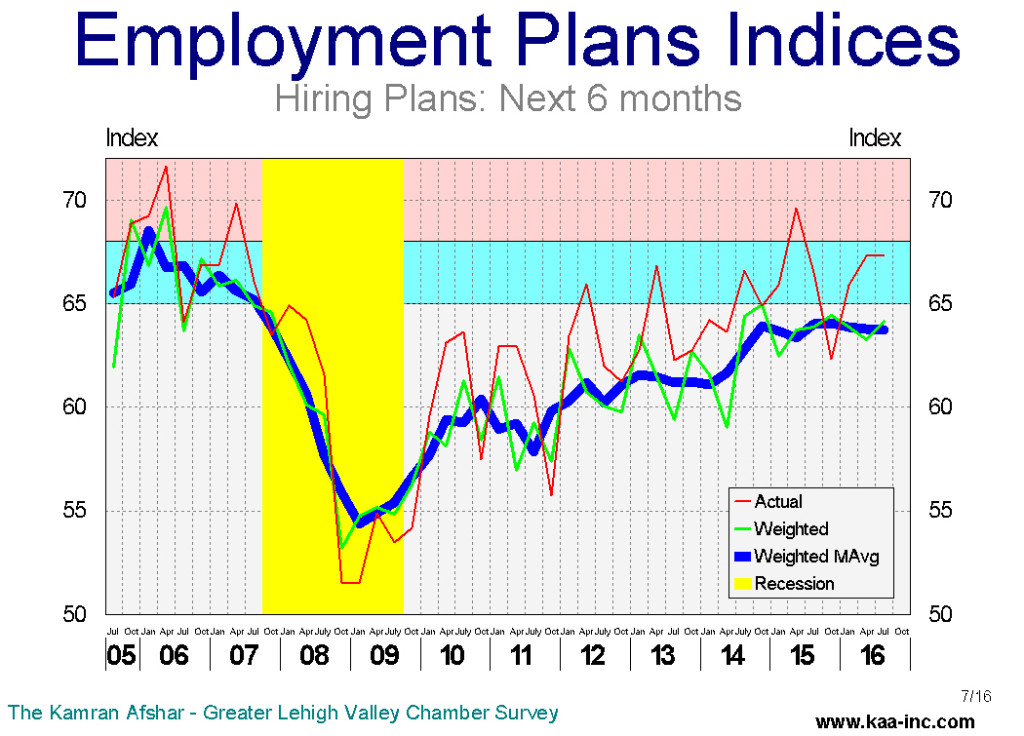 A third of local businesses are planning to hire more people, while only 5% of them plan to lay off employees in the next 6 months. The layoff plans are now similar to what they used to be before the recession.
A third of local businesses are planning to hire more people, while only 5% of them plan to lay off employees in the next 6 months. The layoff plans are now similar to what they used to be before the recession.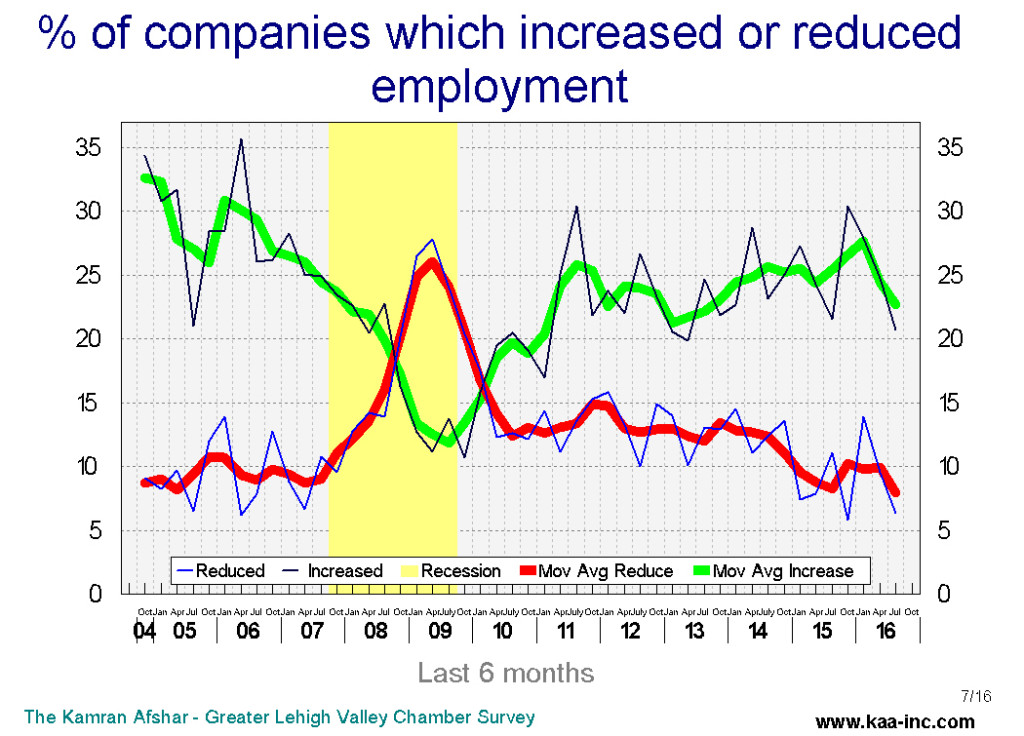
Businesses with more than 100 employees, followed by those with 21 to 50 employees are planning to hire more people in the next 6 months than others.
Similar to the future plans for hiring, the actual hiring index over the last 6 months was almost the same as its April level, but unlike the future hiring plans, the actual hiring index has dropped below its January level.
In July businesses with more than 100 employees reported hiring more people in the last 6 months than the others.
The index of expected revenues is continuing its rebound from its January lows and it is running at its highest level over the last 5 quarters.
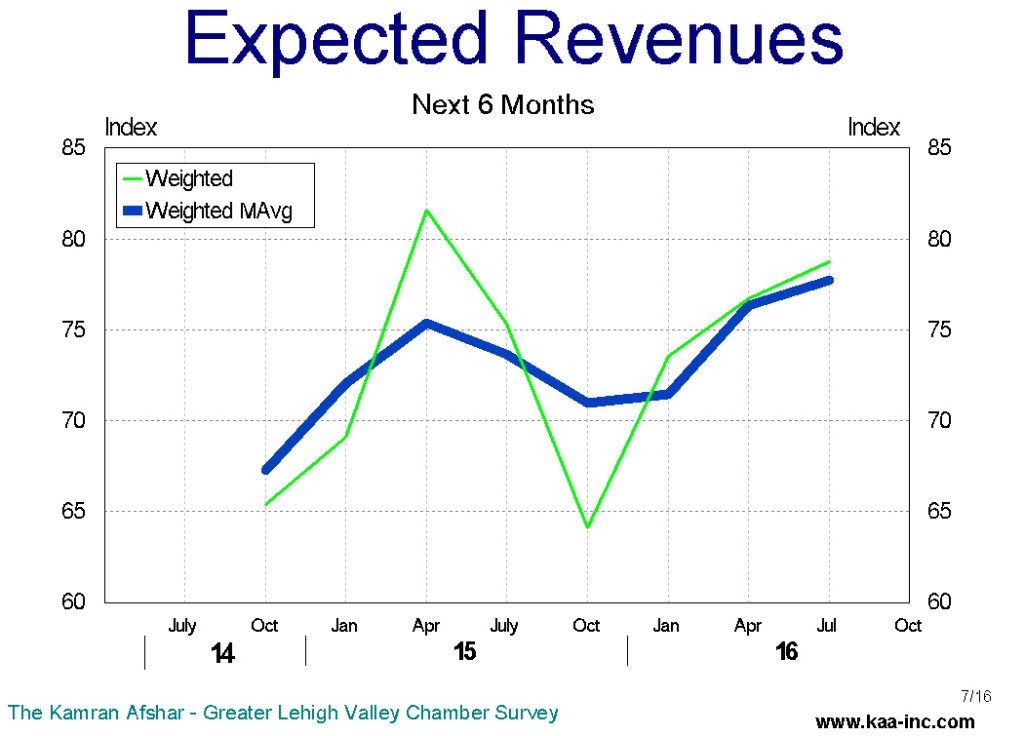
The index of actual revenues, rose above its April level, however, it is still running below its January 2016 level.
The overall confidence in the local economy has dropped since last October and some of this decline can be attributed particularly to the increase in the level of uncertainty generated by this election process. We have observed declines in business confidence in previous general elections over the last 16 years. The Valley’s economy is expected to suffer some anxiety over the next few months as election campaigns further ratchet up their activities. However, since our labor market is running close to where it was during the tight labor markets of 1999-2000 and 2004-05 and an increasing number of businesses are reporting more unfilled job openings, it appears that we would weather this election with minimal, if any negative economic impact locally
Lehigh Valley overall business sentiment slightly down since the beginning of the year
The Kamran Afshar- Greater Lehigh Valley Chamber of Commerce survey of Lehigh Valley businesses is done on a quarterly basis and collects around 700 observations per year. The Employment and Purchasing Index for the Lehigh Valley highlights the results of these surveys.
In July 2016 we conducted our 67th quarterly survey of these series, and according to the survey, business sentiment and the overall confidence in the local economy remained the same as in April, however, it is slightly lower than its January level. The index peaked back in October 2015.
.
In July, the index of plans for future purchases rose by a significant 5% above its April’s level. And while it is still lower than its January’s level, some of its April decline has been reversed.
Actual expenditures over the last 6 months, however, have been trending down since last October.
Hiring plans index for the next 6 months, is a shade higher than its April level, however, it has been trending at an almost constant level for the last year-and-a-half. And of more importance, this level is very close to the range which is historically associated with strong employment growth. A third of local businesses are planning to hire more people, while only 5% of them plan to lay off employees in the next 6 months. The layoff plans are now similar to what they used to be before the recession.
A third of local businesses are planning to hire more people, while only 5% of them plan to lay off employees in the next 6 months. The layoff plans are now similar to what they used to be before the recession.
Businesses with more than 100 employees, followed by those with 21 to 50 employees are planning to hire more people in the next 6 months than others.
Similar to the future plans for hiring, the actual hiring index over the last 6 months was almost the same as its April level, but unlike the future hiring plans, the actual hiring index has dropped below its January level.
In July businesses with more than 100 employees reported hiring more people in the last 6 months than the others.
The index of expected revenues is continuing its rebound from its January lows and it is running at its highest level over the last 5 quarters.

The index of actual revenues, rose above its April level, however, it is still running below its January 2016 level.
The overall confidence in the local economy has dropped since last October and some of this decline can be attributed particularly to the increase in the level of uncertainty generated by this election process. We have observed declines in business confidence in previous general elections over the last 16 years. The Valley’s economy is expected to suffer some anxiety over the next few months as election campaigns further ratchet up their activities. However, since our labor market is running close to where it was during the tight labor markets of 1999-2000 and 2004-05 and an increasing number of businesses are reporting more unfilled job openings, it appears that we would weather this election with minimal, if any negative economic impact locally
Does Anybody still remember what we used to call inflation, what happened to it?
Before the Great Recession, inflation was rising at a pretty healthy rate, reaching as high as 5.6%, however, the recession wiped out that inflation alongside 8.7 million payroll jobs, a booming housing market, more than 500 commercial banks as well as thousands of other businesses.
!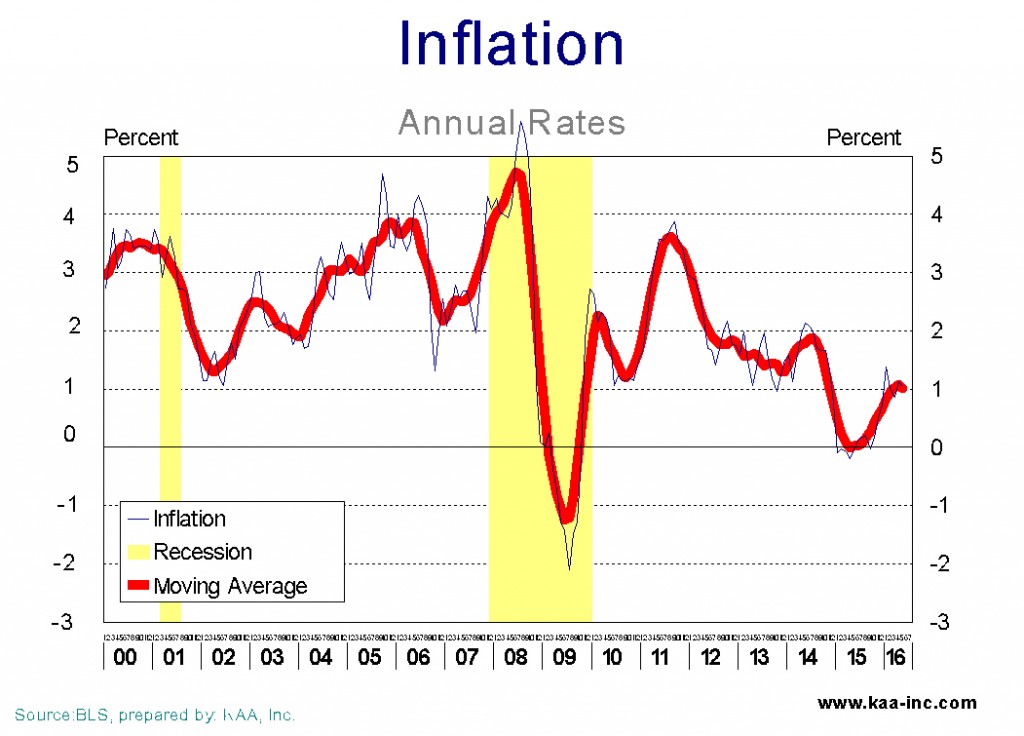
The FED was not all that active during the months leading to the Great Recession. They basically disregarded a number of alarms raised by relevant banking data. At the time the solution appeared to be changing the definition or down grading the importance of the indicators which raised alarms about the liquidity of the US banking system.
The FED eventually discovered that the alarms were for real and switching them off did not remove the problem, and to its credit, it then went to town on raising the money supply and helping many banks fend off bankruptcy. The FED continued pushing high powered money into the economy way after the official end of the recession; by the middle of 2014 the monetary base was almost 5 times its pre-recessionary level.
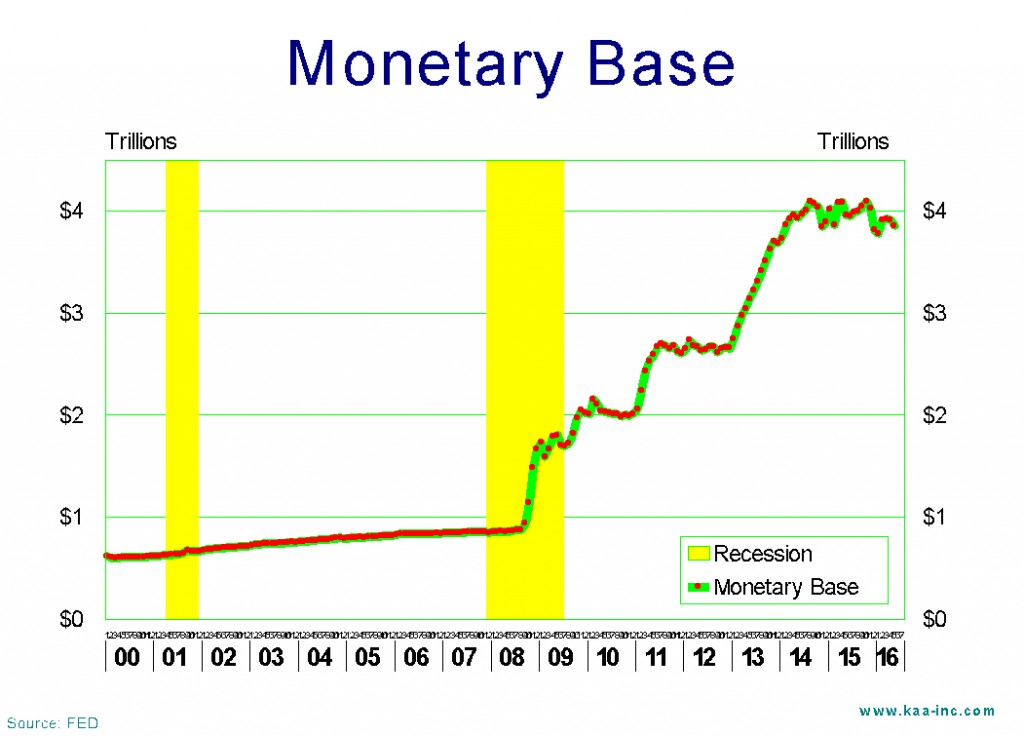
The rapid increase in the monetary base did ring all the inflation alarm bells, and this time round everybody paid attention, however, no inflation appeared. Many monetarists of the 1970s and 80s are turning in their graves, as they theorized, affirmed and predicted that large increases in the money supply, and by which they meant things like 20% or 30%, will be translated into hyperinflation in a relatively short period of time. And of course the German hyperinflation of the early 1920s was a clear proof of the concept. But inflation didn’t come! At 1.0% we are much closer to deflation than anything resembling what used to be called inflation.
What gives? The Great Recession does. The economy was so badly mauled and battered that the velocity of money (that is the rate of circulation of money) crashed, like many other things in the economy, and while a lot more money was being pushed into the system, since it was circulating at a slower and slower pace, it did not cause the expected inflation, and it appears that its is not going to do so anytime soon. On top of that, the crash of oil prices over the last couple of years which was accompanied with declines in the prices of many other raw materials have almost locked the inflation rate in low gear.
As the recovery started to move ahead faster and unemployment rate dropped we all expected the velocity of money to rise, as it did in every recovery until now. This time round it didn’t, actually velocity of money recorded a very small increase after the start of the recovery, and then it again started to decline, albeit at a much more orderly pace than before. And while there are a variety of explanation for the continuing decline in rate at which money circulates in the economy, including the wider use of electronic money, the fact is that the velocity of money is continuing to drop.
Despite of having no inflation, the FED is slowly reducing the monetary base, just in-case all of this discussion about the new normal is a fancy way for economists to say, we really don’t understand why inflation is this low!
Economist gives state of economy address
Mark Reccek , WFMZ.com Reporter, news@wfmz.com
Posted: 5:52 AM EDT Jun 09, 2016
ALLENTOWN, Pa. –
Economist Kamran Afshar, PhD, of Kamran Afshar Associates, Inc. (KAA), examined the state of the economy, both local and national, during a presentation Wednesday afternoon at the LC Bar Association in Allentown.
According to Afshar, Lehigh Valley businesses during the monthly of April saw the largest drop in the index of future purchases.
“Businesses significantly cut back on that one thing,” he said, adding the political election cycle leads to uncertainty. “Still a good number of them are expanding.”
In terms of hiring the last six months, there has been a slight drop. The number currently is about 12 percent, compared to 10 percent before the Great Recession.
“However, the number of business who have actually increased the numbers of employees is significantly higher than those that have reduced the number of employees they have,” he said.
Afshar also provided a forecast for hiring in the Lehigh Valley.
“Our current forecast for the balance of the summer is we are not going to see significant increases in employment,” he said. “By the end of the summer we are going to start to see a turnaround but we are at this point in a relatively flat area for net hiring.”
The causes, he said, are due to businesses beginning to become concerned with events that are occurring, and as businesses hire more employees they run out of the type of employees they seek to hire at the prices they are willing to pay.
Unemployment in the Lehigh Valley has decreased, Afshar also said, noting about 20,000 individuals are currently searching for employment.
“However, when you look at the initial unemployment claims, it has dropped to the level that is historically associated with a tight labor market,” he said. “If this trend continues, and I expect it to continue through the summer months at least, this would be the fourth time in the last 30 years that the Lehigh Valley has gone into a tight labor market.”
Unemployment will continue because individuals out of the employment market are not equipped to handle changes associated with certain jobs.
“At least for the next seven months you are going to see a tight labor market,” Afshar added.
Nationally, according to Afshar, the Gross Domestic Product, which crashed during the Great Recession, did rebound but then leveled off between 2 and 4 percent.
“The importance of that is we need to get the economy to about 3 and 3.5 percent,” he said. “Beyond that growth would be very slow.”
Afshar noted the economy typically “gets hot” when growth moves beyond 2.5 percent.
“Last quarter growth was really bad,” he said. “We are hovering around 2 percent growth for the year.”
The May results indicated only 38,000 new employees added to the job market
Almost 200,000 new jobs have been created every month. Since the start of the economic recovery, 80 percent of all the jobs created are full-time jobs, not part-time.
“It is a significant growth,” he said. “Employment is increasing, and that is real.”
Those unemployed for 27 or more weeks, at one point, numbered 7 million. That number has dropped to about 2 million.
Afshar also said many jobs that have left will never return “not because they have gone to China, but because they have gone away.”
“Technology has taken a lot of those [jobs],” he said. “Technology changes and the pace of that change is increasing and has become more rapid.”
Adjusted for inflation, real wages increased over the past 38 years from only $41,000 to $42,500, which amounts to 4.4 percent.
“Real wages have not increased,” he said.
The causes, he said, are due to the automation of manufacturing, which require fewer employees to do a job.
to read more go to:
http://www.wfmz.com/news/news-regional-lehighvalley/economist-gives-state-of-economy-address/39974228?item=1
Lehigh Valley is about to enter its fourth tight labor market in 30 years
The number of initial unemployment claims, which shows the size of the newly unemployed in the Lehigh Valley is trending at 14% below its last year’s level as of April 2016. This indicator’s long-term trend has been in the range which is historically associated with tight labor market since last November. The last time this indicator dropped below its normal range was before the tight labor market of 2004. If this trend continues, this will be the fourth time in the last 30 years that initial unemployment claims has dropped and stayed below its normal range. The previous three were; 1987, 1998 and 2004. And in all these occasions when the number of initial unemployment claims dropped and stayed below its normal range, a tight labor market ensued.
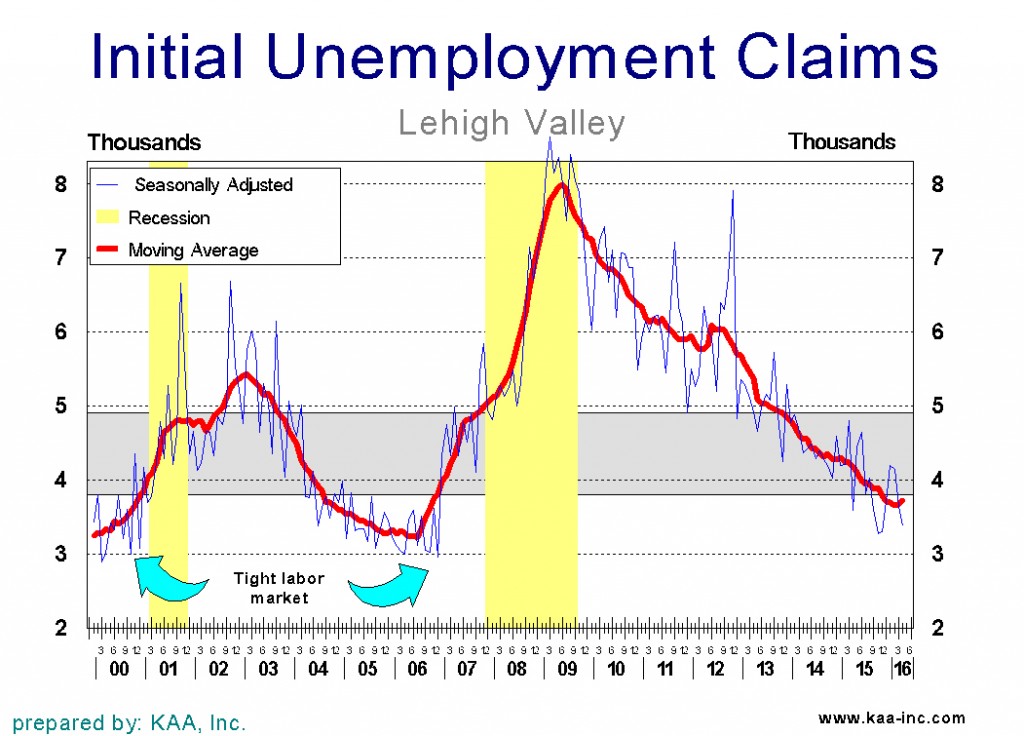
During the worst days of the Great Recession the number of initial unemployment claims exceeded 8,000. It should be noted that the Valley’s labor market went from tight in October 2006, to flooded by March 2009. This caused a rapid increase in the number of newly unemployed in a short period of time, by far the worst labor market in the last 30 years.
The continuing unemployment claims, shows the number of people who are receiving unemployment checks due to loss of job in the previous months. This is a very good indicator of the locally available labor pool.
Continuing unemployment claims also rose rapidly as the unemployment rate sky rocketed in the Valley during the Great Recession. This index rose to around 90,000 which roughly translates to 40,000 people receiving unemployment checks by March 2009.
The Index of continuing unemployment claims is also trending well below its last year’s level. Roughly translating the index shows around 12,000 people received unemployment checks in April. During the same period there were more than 23,000 people in the Valley who were actively looking for a job, which means that there were also another 12,000 people looking for work in April without the benefit of unemployment checks.
Since the end of 2015, the Valley’s labor force has increased by 3,600 new job seekers, that is in 4 months, the local labor force’s expansion was equivalent to it annual growth in the years past. And this is good news since it indicates that more of the discouraged workers are coming back to the labor force.
While unemployment rate rose by close to one percentage point since last December, almost the entire increase in this rate was due to the expansion of the labor force.
Being a job seeker is rarely fun, however, if the current trends continue, this would be one of the best times in the last 30 years to be looking for a job. As we expect to see a lot more new entrants to the labor market as well as more wage increases as the Valley enters its fourth tight labor maker in 30 years.





